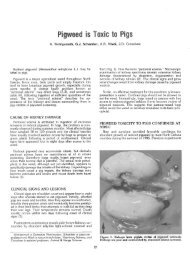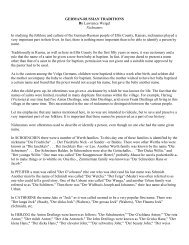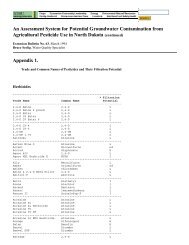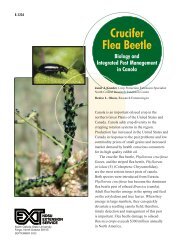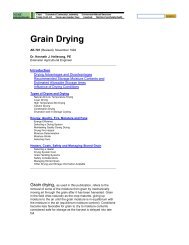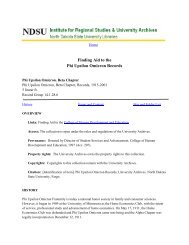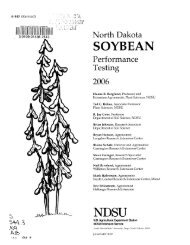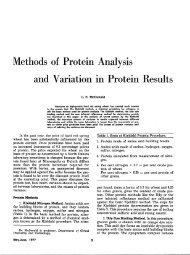germans from russia in fort collins, 1900-2000 - Libraries
germans from russia in fort collins, 1900-2000 - Libraries
germans from russia in fort collins, 1900-2000 - Libraries
You also want an ePaper? Increase the reach of your titles
YUMPU automatically turns print PDFs into web optimized ePapers that Google loves.
WORK RENDERS LIFE SWEET: GERMANS FROM RUSSIA IN FORT COLLINS<br />
was rigidly oriented north-south and seemed<br />
to fit perfectly the general pattern of construction<br />
<strong>in</strong> Russia. Moreover, Alta Vista, or<br />
Spanish Colony, Great Western’s hispanic<br />
labor settlement northwest of Andersonville,<br />
exhibits no such north-south arrangement. 50<br />
Ebers also po<strong>in</strong>ts out that post-flood<br />
Buck<strong>in</strong>gham and Andersonville were unique<br />
<strong>in</strong> that, unlike Alta Vista or m<strong>in</strong><strong>in</strong>g towns,<br />
these neighborhoods were not true company<br />
towns. Andersonville was private enterprise,<br />
while the houses <strong>in</strong> Buck<strong>in</strong>gham were a collaboration<br />
of the sugar company and beet<br />
farm owners. The neighborhoods did have<br />
some limited similarities to company towns,<br />
particularly that the factory was the focal<br />
po<strong>in</strong>t around which the towns were established.<br />
But there was not a company store or<br />
company-endorsed (often enforced) architectural<br />
standard. 51 A small, privately-owned<br />
grocery store did emerge early <strong>in</strong><br />
Buck<strong>in</strong>gham’s history. The false-front, woodframe<br />
retail structure, located near the corner<br />
of First Street and L<strong>in</strong>coln Avenue, appears <strong>in</strong><br />
photographs of the 1904 flood. It has survived<br />
numerous floods s<strong>in</strong>ce then and stands<br />
today. 52<br />
German-Russian Domestic Architecture<br />
The dwell<strong>in</strong>gs of Germans <strong>from</strong> Russia<br />
<strong>in</strong> the Fort Coll<strong>in</strong>s area could vary as widely<br />
as an old wooden boxcar at the edge of a beet<br />
field to a handsome cottage <strong>in</strong> Andersonville.<br />
In some cases, families might have lived <strong>in</strong> a<br />
field-side shanty dur<strong>in</strong>g the beet campaign<br />
(<strong>from</strong> March to November) and resided the<br />
rest of the year <strong>in</strong> a more sophisticated house<br />
near the sugar factory, where the found<br />
employment. The earliest dwell<strong>in</strong>gs <strong>in</strong><br />
Buck<strong>in</strong>gham appear to have been identical<br />
beet shacks based on a plan or kit common to<br />
northern Colorado, while Andersonville featured<br />
more high-style cottages. The 1904<br />
flood seemed to have balanced development<br />
<strong>in</strong> both neighborhoods; modest, late Victorian<br />
and, later, simple Craftsman homes replaced<br />
the beet shacks and temporary hous<strong>in</strong>g.<br />
As mentioned before, by late December<br />
1902 Buck<strong>in</strong>gham boasted thirteen houses<br />
measur<strong>in</strong>g twenty-by-twelve feet with four<br />
small, square w<strong>in</strong>dows. The most notable feature,<br />
however, was the shallowly arced,<br />
rounded roof. The dimensions and descriptions<br />
of these shacks resemble those of simi-<br />
Figures 7 and 8.<br />
Top: A typical northern Colorado beet shanty, circa 1923. Bottom: A contemporary photograph<br />
of a beet shanty on Third Street <strong>in</strong> Buck<strong>in</strong>gham. This view is to the southeast. Note the shedroof<br />
addition to the south side and the square w<strong>in</strong>dows. This is most likely a survivor of the<br />
1904 flood. (Top photo <strong>from</strong> U.S. Department of Labor; bottom photo by the author)<br />
SWCA Environmental Consultants Page 14



